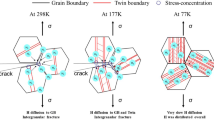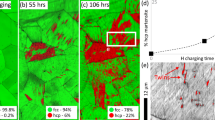Abstract
The strain rate and temperature effects on the hydrogen embrittlement behavior of Fe-20Mn-20Ni-20Cr-20Co and Fe-30Mn-10Cr-10Co (at %) high-entropy alloys were investigated. The Fe-20Mn-20Ni-20Cr-20Co high-entropy alloy exhibits a mechanically stable face-centered cubic (FCC) structure. The as-annealed microstructure of the Fe-30Mn-10Cr-10Co high-entropy alloy consists of a metastable FCC phase with a thermally induced hexagonal close-packed (HCP) martensite. After hydrogen precharging in a 100-MPa hydrogen gas atmosphere, tensile tests were carried out on the two high-entropy alloys. The hydrogen increased the yield strength of both alloys. With the increase in strain rate from 10–4 to 10–2 s–1, the yield strength of the hydrogen-charged Fe-20Mn-20Ni-20Cr-20Co alloy markedly increased, which indicates activation of the strengthening mechanism related to the thermal activation of dislocation motion associated with hydrogen atoms. In contrast, the strain rate effect on the yield strength was insignificant in the Fe-30Mn-10Cr-10Co alloy, where the FCC–HCP martensitic transformation dominated the onset of plasticity. In terms of failure, the combined hydrogen effects that increased the flow stress and decreased the work-hardening rate in the late deformation stage accelerated the occurrence of specimen necking, particularly at a high strain rate, e.g. 10–2 s–1 at 20°C. In addition, the elongation of the hydrogen-charged Fe-20Mn-20Ni-20Cr-20Co and Fe-30Mn-10Cr-10Co alloys increased with the strain rate, which indicates that the hydrogen transport by dislocation motion in late deformation stages assisted both modes of cracking (along grain boundaries and HCP martensite plates) in high-entropy alloys, which resulted in hydrogen-induced intergranular fracture and quasi-cleavage fracture, particularly at relatively low strain rates. Importance of the hydrogen transport by dislocation motion for brittle fracture at 20°C was supported by the test results at –100°C: brittle fracture occurred at higher stress and larger strain as compared to the cases at 20°C for both alloys.







Similar content being viewed by others
REFERENCES
Zhang, L., Wen, M., Imade, M., Fukuyama, S., and Yokogawa, K., Effect of Nickel Equivalent on Hydrogen Gas Embrittlement of Austenitic Stainless Steels Based on Type 316 at Low Temperatures, Acta Mater., 2008, vol. 56, pp. 3414–3421. https://doi.org/10.1016/j.actamat.2008.03.022
Koyama, M., Twinning-Induced Plasticity (TWIP) Steel, Encyclopedia of Materials: Metals and Alloys, 2022, vol. 2, pp. 95–105. https://doi.org/10.1016/b978-0-12-819726-4.00067-3
Cantor, B., Multicomponent High-Entropy Cantor Alloys, Progr. Mater. Sci., 2021, vol. 120, p. 100754. https://doi.org/10.1016/j.pmatsci.2020.100754
Gludovatz, B., Hohenwarter, A., Catoor, D., Chang, E.H., George, E.P., and Ritchie, R.O., A Fracture-Resistant High-Entropy Alloy for Cryogenic Applications, Science, 2014, vol. 345, pp. 1153–1158. https://doi.org/10.1126/science.1254581
Zhao, Y., Lee, D.H., Seok, M.Y., Lee, J.A., Phaniraj, M.P., Suh, J.Y., Ha, H.Y., Kim, J.Y., Ramamurty, U., and Jang, J.I., Resistance of CoCrFeMnNi High-Entropy Alloy to Gaseous Hydrogen Embrittlement, Scripta Mater., 2017, vol. 135, pp. 54–58. https://doi.org/10.1016/j.scriptamat.2017.03.029
Luo, H., Li, Z., and Raabe, D., Hydrogen Enhances Strength and Ductility of an Equiatomic High-Entropy Alloy, Sci. Rep., 2017, vol. 7. https://doi.org/10.1038/s41598-017-10774-4
Pu, Z., Chen, Y., and Dai, L. H., Strong Resistance to Hydrogen Embrittlement of High-Entropy Alloy, Mater. Sci. Eng. A, 2018, vol. 736, pp. 156–166. https://doi.org/10.1016/j.msea.2018.08.101
Nygren, K.E., Bertsch, K.M., Wang, S., Bei, H., Nagao, A., and Robertson, I.M., Hydrogen Embrittlement in Compositionally Complex FeNiCoCrMn FCC Solid Solution Alloy, Current Opinion Solid State Mater. Sci., 2018, vol. 22, pp. 1–7. https://doi.org/10.1016/j.cossms.2017.11.002
Ichii, K., Koyama, M., Tasan, C.C., and Tsuzaki, K., Comparative Study of Hydrogen Embrittlement in Stable and Metastable High-Entropy Alloys, Scripta Mater., 2018, vol. 150, pp. 74–77. https://doi.org/10.1016/j.scriptamat.2018.03.003
Wang, H.Y., Koyama, M., Hojo, T., and Akiyama, E., Hydrogen Embrittlement and Associated Surface Crack Growth in Fine-Grained Equiatomic CoCrFeMnNi High-Entropy Alloys with Different Annealing Temperatures Evaluated by Tensile Testing under In Situ Hydrogen Charging, Int. J. Hydrogen Energy, 2021, vol. 46, pp. 33028–33038. https://doi.org/10.1016/j.ijhydene.2021.07.136
Nygren, K.E., Wang, S., Bertsch, K.M., Bei, H.B., Nagao, A., and Robertson, I.M., Hydrogen Embrittlement of the Equi-Molar FeNiCoCr Alloy, Acta Mater., 2018, vol. 157, pp. 218–227. https://doi.org/10.1016/j.actamat.2018.07.032
Koyama, M., Wang, H.Y., Verma, V.K., Tsuzaki, K., and Akiyama, E., Effects of Mn Content and Grain Size on Hydrogen Embrittlement Susceptibility of Face-Centered Cubic High-Entropy Alloys, Metall. Mater. Trans. A, 2020, vol. 51, pp. 5612–5616. https://doi.org/10.1007/s11661-020-05966-z
Koyama, M., Tasan, C.C., and Tsuzaki, K., Overview of Metastability and Compositional Complexity Effects for Hydrogen-Resistant Iron Alloys: Inverse Austenite Stability Effects, Eng. Fract. Mech., 2019, vol. 214, pp. 123–133. https://doi.org/10.1016/j.engfracmech.2019.03.049
Hirata, K., Iikubo, S., Koyama, M., Tsuzaki, K., and Ohtani, H., First-Principles Study on Hydrogen Diffusivity in BCC, FCC, and HCP Iron, Metall. Mater. Trans. A, 2018, vol. 49, pp. 5015–5022. https://doi.org/10.1007/s11661-018-4815-9
Li, Z., Pradeep, K.G., Deng, Y., Raabe, D., and Tasan, C.C., Metastable High-Entropy Dual-Phase Alloys Overcome the Strength–Ductility Trade-Off, Nature, 2016, vol. 534, pp. 227–230. https://doi.org/10.1038/nature17981
Li, Z.M., Tasan, C.C., Pradeep, K.G., and Raabe, D., A TRIP-Assisted Dual-Phase High-Entropy Alloy: Grain Size and Phase Fraction Effects on Deformation Behavior, Acta Mater., 2017, vol. 131, pp. 323–335. https://doi.org/10.1016/j.actamat.2017.03.069
Ichii, K., Koyama, M., Tasan, C.C., and Tsuzaki, K., Localized Plasticity and Associated Cracking in Stable and Metastable High-Entropy Alloys Pre-Charged with Hydrogen, Proc. Struct. Integr., 2018, vol. 13, pp. 716–721. https://doi.org/10.1016/j.prostr.2018.12.119
George, E.P., Curtin, W.A., and Tasan, C.C., High Entropy Alloys: A Focused Review of Mechanical Properties and Deformation Mechanisms, Acta Mater., 2020, vol. 188, pp. 435–474. https://doi.org/10.1016/j.actamat.2019.12.015
Takaki, S., Furuya, T., and Tokunaga, Y., Effect of Si and Al Additions on the Low Temperature Toughness and Fracture Mode of Fe-27Mn Alloys, ISIJ Int., 1990, vol. 30, pp. 632–638. https://doi.org/10.2355/isijinternational.30.632
Hao, C., Koyama, M., and Akiyama, E., Quantitative Evaluation of Hydrogen Effects on Evolutions of Deformation-Induced ε-Martensite and Damage in a High-Mn Steel, Metall. Mater. Trans. A, 2020, vol. 51, pp. 6184–6194. https://doi.org/10.1007/s11661-020-06021-7
Yang, C.L., Zhang, Z.J., Zhang, P., and Zhang, Z.F., The Premature Necking of Twinning-Induced Plasticity Steels, Acta Mater., 2017, vol. 136, pp. 1–10. https://doi.org/10.1016/j.actamat.2017.06.042
Koyama, M., Gondo, T., and Tsuzaki, K., Microstructure Refinement by Low-Temperature Ausforming in a Fe-Based Metastable High-Entropy Alloy, Metals, 2021, vol. 11, p. 742. https://doi.org/10.3390/met11050742
Koyama, M., Terao, N., and Tsuzaki, K., Revisiting the Effects of Hydrogen on Deformation-Induced γ-ε Martensitic Transformation, Mater. Lett., 2019, vol. 249, pp. 197–200. https://doi.org/10.1016/j.matlet.2019.04.093
Sipos, K., Remy, L., and Pineau, A., Influence of Austenite Predeformation on Mechanical Properties and Strain-Induced Martensitic Transformations of a High Manganese Steel, Metall. Trans. A, 1976, vol. 7, pp. 857–864. https://doi.org/10.1007/Bf02644083
Koyama, M., Kaneko, T., Sawaguchi, T., and Tsuzaki, K., Microstructural Damage Evolution and Arrest in Binary Fe–High-Mn Alloys with Different Deformation Temperatures, Int. J. Fracture, 2018, vol. 213, pp. 193–206. https://doi.org/10.1007/s10704-018-0307-6
Funding
This research was funded by JSPS KAKENHI (JP20H02457, JP21K04702) and the Elements Strategy Initiative for Structural Materials (ESISM) of the Ministry of Education, Culture, Sports, Science, and Technology (MEXT) of Japan (JPMXP0112101000).
Author information
Authors and Affiliations
Corresponding author
Additional information
Translated from Fizicheskaya Mezomekhanika, 2022, Vol. 25, No. 3, pp. 5–14.
Rights and permissions
About this article
Cite this article
Koyama, M., Ichii, K. & Tsuzaki, K. Strain Rate and Temperature Effects on Hydrogen Embrittlement of Stable and Metastable High-Entropy Alloys. Phys Mesomech 25, 385–392 (2022). https://doi.org/10.1134/S1029959922050010
Received:
Revised:
Accepted:
Published:
Issue Date:
DOI: https://doi.org/10.1134/S1029959922050010




